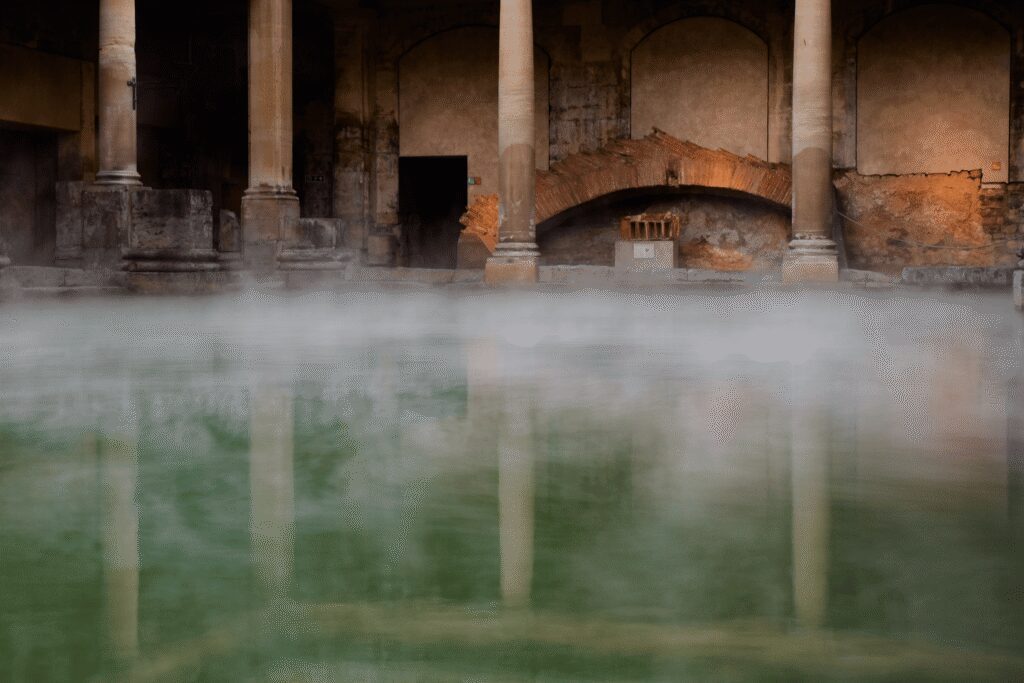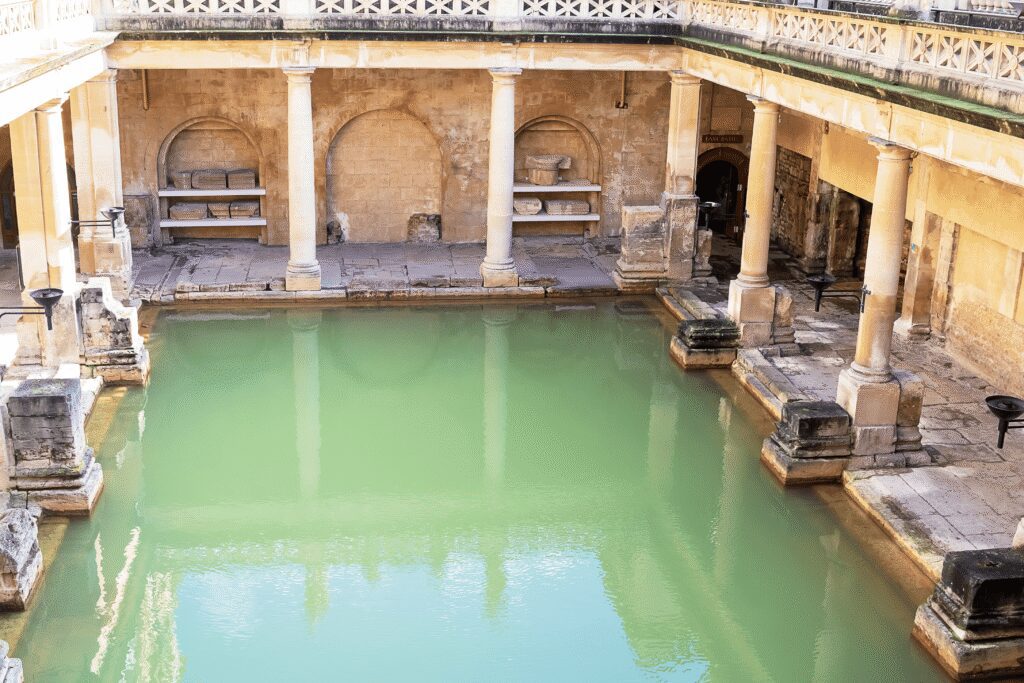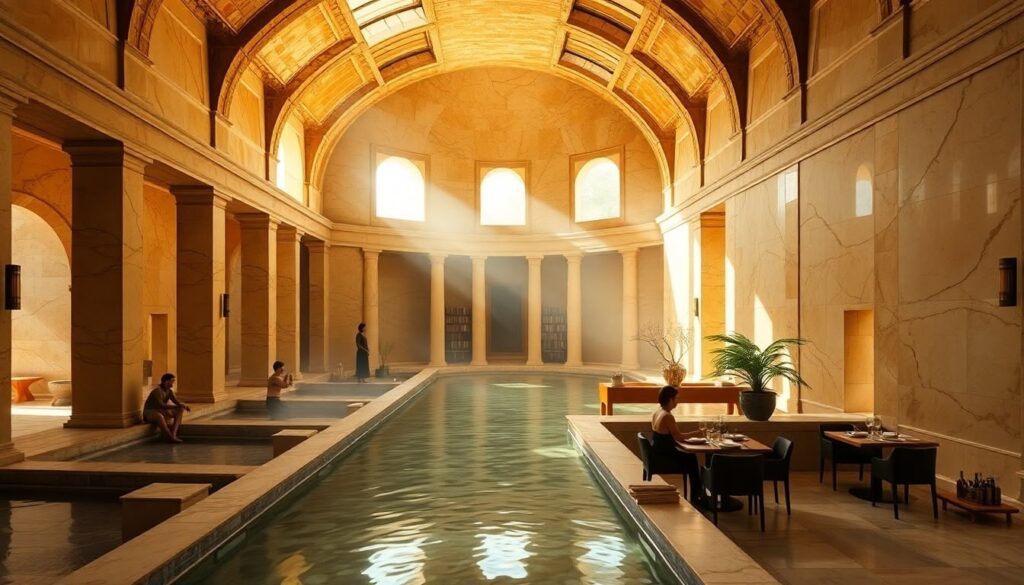Steam rises from the waters as conversations echo against marble walls. For Romans, bathing wasn’t merely about cleanliness—it represented the pinnacle of civilization, a daily ritual that balanced physical health, social connection, and mental restoration. While we’ve spent decades reducing wellness to quick fixes and isolated treatments, the sophisticated bathing culture of ancient Rome understood something we’re only now rediscovering: true wellbeing emerges from the harmonious integration of body, mind, and community.
Our modern wellness industry, valued at over $4 trillion globally, has become increasingly fragmented—offering meditation apps divorced from physical practices, fitness routines separated from nutrition, and treatments that isolate the body from the mind. We’ve lost the holistic approach that once defined human wellness for centuries.
What if the solutions to our contemporary wellness challenges were already perfected thousands of years ago? The Roman thermae—elaborate bathing complexes that served as the centerpiece of daily life—operated on principles so advanced that modern wellness centers are now racing to reintegrate them into contemporary practices.
The Fractured State of Modern Wellness
Today’s approach to wellness often resembles a disconnected collection of practices. We visit sterile gyms to exercise in isolation, book occasional massages as luxury indulgences rather than necessary maintenance, and scroll through meditation apps in solitude. Wellness has become something we “do” rather than a way we live—compartmentalized into discrete activities that rarely connect with one another.
Our typical wellness routines reflect this fragmentation. We might attend a yoga class without connecting the practice to our nutrition. We might soak in a hot bath without understanding its physiological benefits beyond basic relaxation. We pursue wellness goals individually, missing the profound benefits of shared healing experiences that humans have valued throughout history.
This disconnection extends to our relationship with water itself. Despite water covering over 70% of our planet and comprising roughly the same percentage of our bodies, we’ve reduced its role in wellness to simple hydration advice and occasional recreational swimming. The profound therapeutic potential of water—understood intimately by ancient cultures—has been largely forgotten in our modern rush toward technological solutions.
The consequences appear throughout society: rising rates of loneliness alongside increasing burnout, stress-related illness despite more “wellness” options than ever before, and a general sense that despite all our modern advances, something essential is missing from our approach to health and wellbeing.

The Roman Bath: A Marvel of Integrated Wellness
To understand what we’ve lost, we must journey back to ancient Rome, where bathing represented far more than cleanliness. The Roman thermae stood as architectural masterpieces that integrated multiple wellness modalities under a single roof, available to citizens across social classes. These weren’t mere bathhouses but comprehensive wellness centers that modern spas are only beginning to emulate.
The typical Roman bathing sequence reveals a sophisticated understanding of the body that modern science is now validating. Romans moved methodically through a series of spaces, each with distinct therapeutic purposes. They began in the tepidarium (warm room) where the body gradually adjusted to increasing temperatures—a practice that prepared the cardiovascular system and opened the pores. This was followed by time in the caldarium (hot room), where intense heat promoted detoxification through sweating. The sequence concluded in the frigidarium (cold room), where immersion in cold water closed the pores, stimulated circulation, and invigorated the body.
This hot-cold contrast therapy—now trendy in elite athletic recovery programs and luxury spas—was a daily practice for ordinary Romans. The thermae incorporated what we now recognize as essential elements of comprehensive wellness: hydrotherapy, massage, exercise facilities, nutrition (with food vendors and communal dining areas), social connection, and even libraries for mental stimulation. Every aspect of human wellbeing was addressed under one roof, as part of one integrated experience.
Perhaps most striking was the social dimension of Roman bathing. Unlike today’s often solitary wellness pursuits, Roman baths functioned as community centers where people from different social strata interacted. Important business was conducted, ideas were exchanged, and social bonds were strengthened—all while engaging in health-promoting practices. This integration of social connection with physical wellness reflects emerging research suggesting that community and belonging are as crucial to health as diet and exercise.
The Science Behind Roman Bathing Wisdom
What the Romans understood intuitively, modern science now confirms. The contrast therapy at the heart of Roman bathing—alternating between heat exposure and cold immersion—triggers powerful physiological responses. Heat exposure increases blood flow to the skin and muscles, relaxes tissues, and induces a mild stress response that activates cellular repair mechanisms. Cold exposure reduces inflammation, stimulates the vagus nerve (improving nervous system function), and increases circulation and metabolism.
The combination of these treatments appears particularly powerful. Research into contrast therapy shows benefits including improved circulation, enhanced recovery from exercise, reduced muscle soreness, strengthened immune function, and even improved mood through the release of endorphins and other neurotransmitters. The Roman bathing sequence effectively delivered these benefits daily to the entire population.
Beyond the physical effects, the multisensory experience of Roman bathing engaged multiple neurological pathways. The sounds of water and conversation, the varying temperatures, the scents of oils and herbs, and the visual beauty of the architecture created an immersive experience that modern neuroscience recognizes as particularly effective for stress reduction and mental restoration.
The social dimension of Roman bathing also aligns with contemporary research on the health impacts of community connection. Regular positive social interaction has been linked to everything from improved cardiovascular health to enhanced cognitive function and longevity. By combining physical therapy with social engagement, Romans addressed multiple dimensions of health simultaneously—something our modern, often isolated wellness practices frequently fail to accomplish.

The Modern Rediscovery of Roman Bathing Principles
After centuries of moving away from the Roman model, the wellness industry is now experiencing a renaissance of ancient bathing principles. Leading wellness centers around the world are reimagining the thermae for the 21st century, incorporating the key elements that made Roman baths so effective while adapting them to contemporary needs and knowledge.
This revival appears in various forms. The surge in popularity of contrast therapy is perhaps the most direct connection, with facilities offering sequences of saunas, steam rooms, and cold plunges that mirror the Roman progression through tepidarium, caldarium, and frigidarium. The growing interest in hydrotherapy—using water at varying temperatures and pressures for therapeutic purposes—similarly echoes Roman practices.
More significantly, innovative wellness centers are rediscovering the importance of integrating multiple modalities. Rather than offering isolated services, forward-thinking facilities now combine thermal experiences with movement studios, nutrition services, massage and bodywork, meditation spaces, and social areas—creating comprehensive wellness environments reminiscent of Roman thermae.
The social dimension is being reintroduced as well. Community bathing traditions are experiencing a resurgence, from Japanese onsen-inspired facilities to Scandinavian sauna culture and Turkish hammams. These spaces recognize that healing happens more effectively in community than in isolation. Some modern wellness centers now explicitly design for social interaction, with communal relaxation areas and group experiences that foster connection alongside physical therapy.
The architectural consideration of Roman baths—with their emphasis on beauty, natural light, and connection to nature—also influences contemporary wellness design. Today’s most acclaimed wellness spaces feature thoughtful aesthetics and biophilic elements, understanding that environment significantly impacts the healing experience.
Bridging Ancient Wisdom and Modern Practice
The rediscovery of Roman bathing principles offers a compelling blueprint for transforming our approach to wellness. By reintegrating the elements that made the thermae so effective, we can address the limitations of our current fragmented approach while honoring both tradition and science.
The key principles worth reclaiming begin with integration. Rather than treating different aspects of wellness as separate specialties, we can design experiences that simultaneously address physical, mental, and social wellbeing. This might mean wellness centers that combine therapeutic water experiences with movement practices, nutrition, education, and social spaces—all designed to work synergistically rather than as isolated offerings.
The Roman emphasis on accessibility also provides a valuable lesson. While the thermae featured luxury options for the wealthy, basic facilities were available to all citizens, reflecting an understanding that wellness should be a public good rather than an exclusive privilege. As we reimagine wellness for the modern era, expanding access beyond luxury markets represents an important challenge.
Perhaps most importantly, the Roman approach reminds us that wellness works best as a daily practice integrated into normal life, not as an occasional indulgence or emergency intervention. The thermae were used regularly by citizens as part of their routine, creating cumulative benefits that occasional spa visits cannot replicate. Finding ways to incorporate therapeutic practices into everyday life—whether through home rituals, community facilities, or workplace wellness—offers a path toward more sustainable wellbeing.

Practical Applications: Roman Wisdom for Modern Life
While we may not have access to magnificent thermae in our daily lives, we can still incorporate key principles from Roman bathing culture into contemporary wellness routines. These adaptations honor the essence of Roman practice while acknowledging modern realities.
The foundation begins with contrast therapy. Even at home, alternating between hot and cold exposures can deliver significant benefits. This might involve finishing a hot shower with 30 seconds of cold water, or using a home sauna followed by a cool shower. For those with access to appropriate facilities, establishing a regular practice of sauna or steam room use followed by cold immersion more closely replicates the Roman experience.
Water itself deserves renewed attention in our wellness routines. Beyond basic hydration, therapeutic uses might include Epsom salt baths for muscle recovery, contrast foot baths to improve circulation, or swimming in natural bodies of water when available. These practices connect us to water’s healing properties in ways Romans inherently understood.
The social dimension can be reclaimed by making wellness activities communal rather than solitary. This might mean joining group fitness classes, establishing regular wellness dates with friends, or seeking out community-oriented facilities like public pools, community saunas, or hot springs. The conversation and connection that happens alongside physical practices amplifies benefits in ways we’re only beginning to measure.
Multisensory engagement represents another accessible aspect of Roman bathing wisdom. Creating bathing rituals that engage multiple senses—perhaps with essential oils for scent, music for auditory stimulation, and beautiful surroundings for visual pleasure—enhances the neurological benefits of the experience. This attention to sensory details transforms routine hygiene into therapeutic practice.
Perhaps most importantly, we can adopt the Roman view of wellness as an integrated daily practice rather than a compartmentalized activity. This might mean designing personal routines that naturally combine physical practices with social connection and mental restoration, or seeking facilities that offer multiple modalities under one roof.
The Future of Wellness: Learning from the Past
As we look toward the future of wellness, the Roman thermae offer both inspiration and practical guidance. They remind us that many of our “innovations” are actually rediscoveries, and that sometimes progress means returning to wisdom we’ve forgotten rather than inventing something entirely new.
The most promising developments in contemporary wellness reflect this integration of ancient wisdom with modern knowledge. We see it in the rise of comprehensive wellness centers that combine multiple modalities. We recognize it in the growing emphasis on community-based healing. We observe it in architectural trends that prioritize beauty and connection to nature as essential elements of healing environments.
For the wellness industry, this historical perspective offers a roadmap for evolution beyond fragmented services toward more integrated, accessible, and effective offerings. For individuals, it provides permission to seek wellness experiences that nourish all aspects of being—physical, mental, social, and even spiritual—rather than focusing narrowly on isolated goals.
The Roman thermae remind us that true wellness has never been about quick fixes or isolated interventions. It emerges from thoughtful daily practices that honor the body’s wisdom, foster community connection, engage the senses, and recognize the interconnectedness of all aspects of health. By reclaiming these principles, we aren’t simply adopting ancient practices—we’re remembering essential truths about human wellbeing that transcend time and culture.
Embracing the Thermae Philosophy in Modern Life
The journey back to integrated wellness begins with shifting our perspective. Rather than viewing wellness as a collection of separate activities—exercise here, relaxation there, social connection elsewhere—we can adopt the thermae philosophy that sees these elements as inherently connected. This mindset treats wellness not as something we do but as a way we live, integrating therapeutic practices into the fabric of daily life.
In practical terms, this might mean evaluating our current wellness practices for gaps and opportunities. Does our routine include contrast therapy to stimulate circulation and recovery? Do we make space for social connection alongside physical practices? Have we created environments that engage multiple senses and promote restoration? Are our wellness activities accessible enough to become truly regular practices rather than occasional indulgences?
For wellness professionals and facility designers, the Roman model offers even more extensive applications. How might we design spaces that naturally foster community alongside healing? What would it mean to create truly integrated facilities where multiple modalities complement each other? How can we expand access to these practices beyond luxury markets? The thermae provide a template that can be adapted to contemporary needs and constraints.
The ultimate lesson from Roman bathing culture may be about balance—between activity and rest, heat and cold, solitude and community, stimulation and restoration. In a culture that often celebrates extremes, the measured wisdom of the thermae reminds us that wellbeing emerges from the thoughtful integration of complementary elements, not from pursuing any single approach to excess.
As we reclaim this balanced approach, we may find that many of our modern wellness challenges become more manageable. The fragmentation that characterizes contemporary life begins to heal as we recognize the connections between different aspects of wellbeing. The isolation that contributes to many health issues diminishes as we embrace more communal healing practices. The stress of constant productivity eases as we remember the importance of regular restoration.
The wisdom of Roman bathing culture isn’t just a historical curiosity—it’s a practical philosophy with profound implications for how we understand and pursue wellness today. By looking back to this sophisticated tradition, we find not only specific techniques worth reclaiming but a more integrated vision of human flourishing that our fragmented modern approach has often missed. In the steam and conversation of the ancient thermae, we discover not just what we’ve forgotten about bathing, but what we’ve forgotten about wellness itself.

